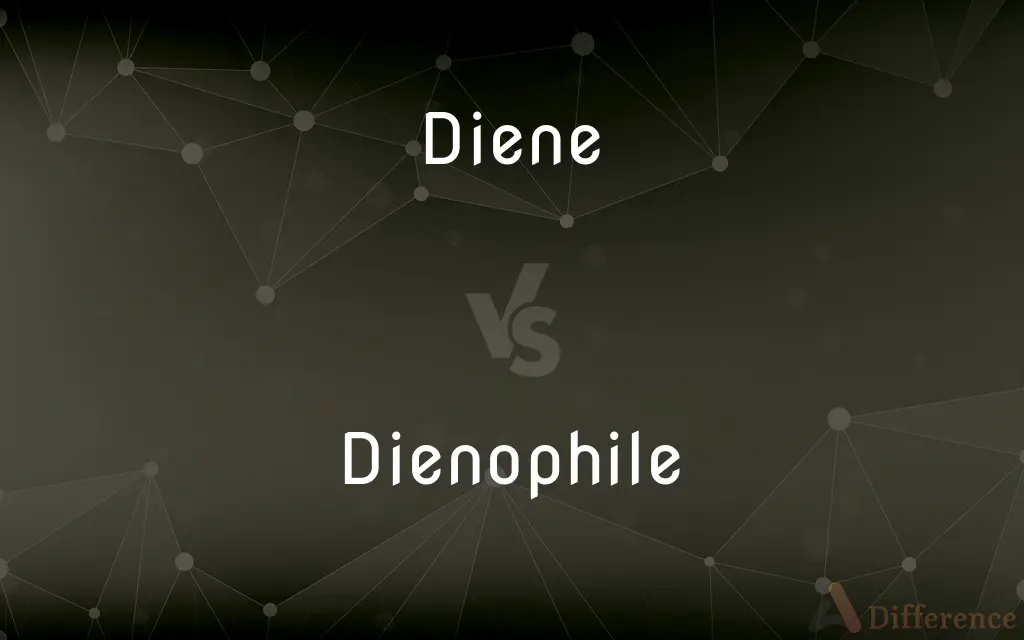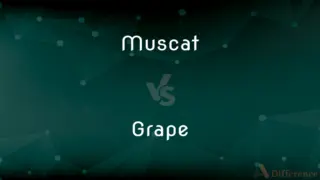Diene vs. Dienophile — What's the Difference?
By Tayyaba Rehman — Updated on September 27, 2023
Diene is a hydrocarbon that contains two double bonds between carbon atoms. Dienophile is a compound with an affinity for dienes, typically containing a double or triple bond, reacting with dienes in Diels-Alder reactions.

Difference Between Diene and Dienophile
Table of Contents
ADVERTISEMENT
Key Differences
Diene and Dienophile are terms frequently encountered in the field of organic chemistry, relating to different components involved in specific chemical reactions. A Diene is a molecule containing two double bonds, typically found in hydrocarbons. In contrast, a Dienophile is a compound that readily reacts with dienes, characterized by the presence of a double or triple bond, making it electron-poor.
The nature of Diene is such that it usually possesses conjugated double bonds, allowing it to readily participate in reactions due to its electron-rich configuration. Conversely, a Dienophile exhibits an affinity for the electron-rich dienes, thereby acting as an ideal reaction partner, enabling the formation of cyclohexene rings through Diels-Alder reactions.
Dienes play a crucial role in various chemical syntheses and polymerization processes due to their reactivity and versatility. They can be found in natural compounds and are often used to synthesize complex molecules. On the other hand, Dienophiles, due to their electron-deficient nature, actively seek out and react with dienes, facilitating the creation of diverse and intricate molecular structures.
In the realm of chemical reactions, Diene and Dienophile come together in a concertedly symphonic manner, enabling the synthesis of ring structures, crucial in the creation of many pharmaceuticals and synthetic materials. It's the interplay between the electron-rich Diene and the electron-poor Dienophile that makes their reaction fruitful, adding significant value to organic synthesis endeavors.
While Diene offers a fertile ground for reactions with its electron-rich structure, the Dienophile brings the essential complementarity needed for reaction progression. The relationship between Diene and Dienophile is inherently symbiotic, paving the way for the synthesis of myriad compounds essential to human life and technological advancement.
ADVERTISEMENT
Comparison Chart
Nature
Hydrocarbon with two double bonds.
Compound with an affinity for dienes.
Bond Characteristic
Typically has conjugated double bonds.
Contains double or triple bonds.
Role in Reaction
Acts as the electron donor in reactions.
Acts as the electron acceptor in reactions.
Usage
Involved in polymerization processes.
Essential for synthesis of cyclic compounds.
Reactivity
High reactivity due to electron-rich configuration.
Reacts readily with electron-rich dienes.
Compare with Definitions
Diene
A versatile molecule used in the synthesis of various organic compounds.
Utilizing a diene allowed chemists to construct complex molecules effectively.
Dienophile
An electron-deficient species making it prone to reactions with electron-rich dienes.
The dienophile played a crucial role in the reaction by accepting electrons from the diene.
Diene
A hydrocarbon containing two double bonds.
Butadiene is a diene often used in the production of synthetic rubber.
Dienophile
A compound enabling the creation of diverse molecular structures when reacting with dienes.
Employing a dienophile in the reaction allowed for the synthesis of a variety of compounds.
Diene
A compound crucial in polymerization processes.
The presence of a diene facilitated the polymerization process, leading to the formation of a durable polymer.
Dienophile
A molecule essential in the synthesis of cyclohexene rings.
The dienophile was crucial in the formation of the cyclohexene ring in the final product.
Diene
A molecule integral in chemical synthesis due to its two conjugated double bonds.
The diene in the reaction acted as an electron donor, enabling the synthesis of a cyclic compound.
Dienophile
A molecule characterized by the presence of a double or triple bond.
The presence of a double bond in the molecule confirmed it as a dienophile.
Diene
An electron-rich species making it highly reactive.
The reactivity of the diene was instrumental in driving the reaction forward.
Dienophile
A compound that readily reacts with dienes in Diels-Alder reactions.
The dienophile, with its electron-poor structure, quickly reacted with the diene to form a ring structure.
Diene
In organic chemistry a diene ( DY-een) (diolefin ( dy-OH-lə-fin) or alkadiene) is a covalent compound that contains two double bonds, usually among carbon atoms. They thus contain two alkene units, with the standard prefix di of systematic nomenclature.
Dienophile
(organic chemistry) A compound that readily reacts with a diene; especially an alkene in the Diels-Alder reaction.
Diene
(organic chemistry) An organic compound, especially a hydrocarbon, containing two double bonds.
Common Curiosities
What makes a diene reactive?
The presence of two conjugated double bonds makes a diene electron-rich and highly reactive.
Why is a diene important in organic synthesis?
Diene's high reactivity and presence of conjugated bonds make it integral in synthesizing diverse and complex organic compounds.
Can dienophiles be used to synthesize cyclic compounds?
Yes, dienophiles react with dienes to synthesize cyclic compounds, particularly in Diels-Alder reactions.
What kind of bond does a dienophile typically contain?
A dienophile typically contains a double or triple bond.
Share Your Discovery

Previous Comparison
Muscat vs. Grape
Next Comparison
Preoperative vs. PerioperativeAuthor Spotlight
Written by
Tayyaba RehmanTayyaba Rehman is a distinguished writer, currently serving as a primary contributor to askdifference.com. As a researcher in semantics and etymology, Tayyaba's passion for the complexity of languages and their distinctions has found a perfect home on the platform. Tayyaba delves into the intricacies of language, distinguishing between commonly confused words and phrases, thereby providing clarity for readers worldwide.














































